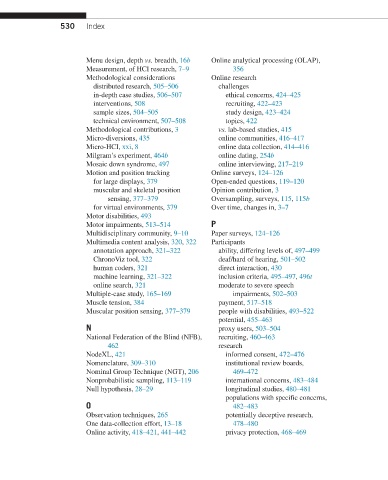Page 537 -
P. 537
530 Index
Menu design, depth vs. breadth, 16b Online analytical processing (OLAP),
Measurement, of HCI research, 7–9 356
Methodological considerations Online research
distributed research, 505–506 challenges
in-depth case studies, 506–507 ethical concerns, 424–425
interventions, 508 recruiting, 422–423
sample sizes, 504–505 study design, 423–424
technical environment, 507–508 topics, 422
Methodological contributions, 3 vs. lab-based studies, 415
Micro-diversions, 435 online communities, 416–417
Micro-HCI, xxi, 8 online data collection, 414–416
Milgram’s experiment, 464b online dating, 254b
Mosaic down syndrome, 497 online interviewing, 217–219
Motion and position tracking Online surveys, 124–126
for large displays, 379 Open-ended questions, 119–120
muscular and skeletal position Opinion contribution, 3
sensing, 377–379 Oversampling, surveys, 115, 115b
for virtual environments, 379 Over time, changes in, 3–7
Motor disabilities, 493
Motor impairments, 513–514 P
Multidisciplinary community, 9–10 Paper surveys, 124–126
Multimedia content analysis, 320, 322 Participants
annotation approach, 321–322 ability, differing levels of, 497–499
ChronoViz tool, 322 deaf/hard of hearing, 501–502
human coders, 321 direct interaction, 430
machine learning, 321–322 inclusion criteria, 495–497, 496t
online search, 321 moderate to severe speech
Multiple-case study, 165–169 impairments, 502–503
Muscle tension, 384 payment, 517–518
Muscular position sensing, 377–379 people with disabilities, 493–522
potential, 455–463
N proxy users, 503–504
National Federation of the Blind (NFB), recruiting, 460–463
462 research
NodeXL, 421 informed consent, 472–476
Nomenclature, 309–310 institutional review boards,
Nominal Group Technique (NGT), 206 469–472
Nonprobabilistic sampling, 113–119 international concerns, 483–484
Null hypothesis, 28–29 longitudinal studies, 480–481
populations with specific concerns,
O 482–483
Observation techniques, 265 potentially deceptive research,
One data-collection effort, 13–18 478–480
Online activity, 418–421, 441–442 privacy protection, 468–469

